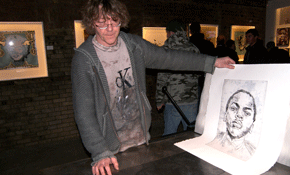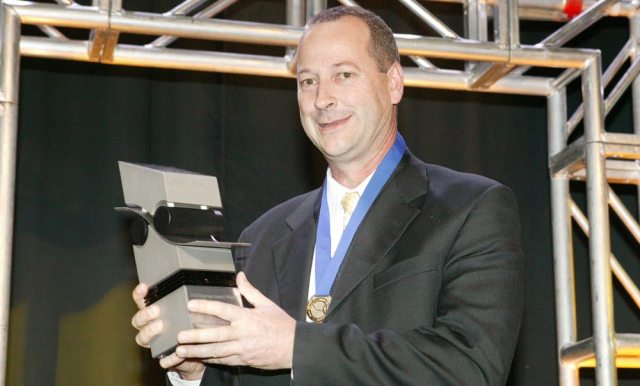
Since Banksy propelled graffiti and urban art into the mainstream, young artists from across the globe have taken to the medium in unprecedented numbers, incorporating wood blocking, linocutting, etching and screen printing into their works. The organisation at the fulcrum of this unusual movement is London-based gallery Black Rat Press, which prides itself on marrying street art with old print techniques.
Since the gallery was created in October last year, the firm has built up a roster of some of the biggest names in urban art – everyone from Nick Walker to D*face and Swoon has collaborated with Black Rat. The fact that the gallery makes around £350,000 a day (approx. $AU716,000) at an average show, despite being barely eight months old, is testament to the growing phenomenon of what is ostensibly an underground movement that is increasingly going overground.
Black Rat Press was born out of Mike Snelles’ frustration at dealing in work by modern British artists. He was previously trading prints by art luminaries such as Hockney and Henry Moore, an occupation that he describes as dealing with dead people’s things.
Everyone else that was doing street art printing had a very do-it-yourself approach, explains Snelles. They were buying their own press and learning how to print on it from scratch.
We’d come from mod-Brit [modern British] where there are very high production values in print, and it was all about using the old print techniques. I thought if we could apply those techniques to street art images it would be something that wasn’t available anywhere else.
Snelles says that it was easy to get big-name artists like D*Face and Swoon on board by offering them the opportunity to make their first etchings or other print techniques that were alien to them. So strong was the allure of trying out old printing processes that the company managed to poach D*Face from local rival screen printer Pictures on Walls.
I offered to make a print for him that was different from what they made, says Snelles. I consciously tried not to be pretentious with it, but I said I’d do a project with him that involved etching and was something a bit different. After that, he started coming to us for all of his prints. At the time I was trying to be sensitive to the fact that Pictures on Walls had existed for a while. They do their own thing and they do it well. But I think we’re two different kinds of businesses.
Japanese paper
Getting Ian Wilkinson, co-founder of Goldmark Atelier, the Rutland-based Goldmark Gallery printer, on board was also a major coup for Snelles. It meant that Black Rat Press could realise Snelles’ vision of producing high-quality prints using traditional tools and materials. Wilkinson is passionate about historic printing, preferring to source traditional handmade paper from Japan. The printer owns a 130-year-old litho press.
Such is the company’s dedication that sourcing and sampling material for some prints can take up to six months. This approach isn’t without its complications. The policy for paper in Japan is that once the paper maker is dead then the paper, and the recipe for making that paper, dies with him, explains Wilkinson.
On a particular Swoon piece all of the prints had been approved on Japanese paper, only for Wilkinson to find out when phoning through the order that the paper maker had died. Most people wouldn’t be able to tell the difference but it was a completely different take on ink on that paper, so we couldn’t get back to what we had originally, he says.
The artists sometimes spend weeks staying in Rutland with the printer, where they are slowly encouraged to try out new printing processes. In some cases they come in and they may have seen some etching somewhere and not actually got their teeth into it. We’re pretty proactive in getting them to just experiment a little bit, explains Wilkinson. We know from experience that once they do start experimenting, some will narrow their field down and say ‘wood block isn’t for me’ and other artists will just open up completely, ending up with a litho, a silk screen and an etching.
Part of the popularity of these prints must, at least in part, be attributed to the quality and amount of effort that goes into producing them. The printer shelled out £7,000 on a new etching press to produce limited-edition hand-painted etchings by Swoon. And at a London print show organised by Black Rat, customers were allowed to watch the process of etchings being created, allowing them to see how long it takes just to ink up the plates and get a lay out of them. It’s not just sticking it in a machine, pressing a button and off it goes, says Wilkinson. For example, for Black Le Rat’s Homeless in Paris, the etched black lay had to go through however many impressions to get a good solid print. The background two colour silk is difficult to put in a lay and have it the same every time. Things flatten and move.
Snelles concurs entirely with the idea of not resting until the result is exceptional, revealing that the gallery sometimes throws away just as many prints as it sells in the quest to make each piece absolutely perfect. If people are paying for a print then I want to be able to stand by the process, he says.
Each project can take from three to five months to produce from the initial concept, and the artworks usually sell for between £150 and £300 – real entry-level prices, Snelles says. But prices can jump very quickly, which explains the hordes of people queuing up to buy them. Street art is a new collectors’ market and values go up very quickly, says Snelles. We sold a Nick Walker print for £295 at a show last November and it made £5,500 in February.
A lot of people like the refinement of an etching, says Snelles, while with screen printing you can certainly not master it, but you can get a hang of how to do simple things relatively quickly. Silk-screen printing delivers the most vivid representation in terms of things like colour, adds Wilkinson.
Snelles says it’s the romanticism of it all for the artists, the fact that these images are steeped in the whole history of making print, that makes the techniques so appealing. Market demand for the resulting prints should safeguard their rise in popularity.
CASE STUDY: THE ARTIST
Matt Small is a traditional urban artist who paints directly onto used pieces of found metal. He studied old print techniques such as screen, etching and lithography at art college. They weren’t avenues he actively pursued until producing his first etching for Black Rat Press. Now his works cover woodcuts, linocuts, etchings and paintings. He works from his studio in north London.
What processes do you prefer?
Linocuts and woodcuts. When you’re developing a woodcut you know what’s going to happen immediately. Its like you’re making a piece of sculpture because the cutting is a piece of art in its own right.
How do you see the future of street art developing?
I think it’s always going to be out there. It’s always going to come and go. It began at the grass roots level and it’s a pity that some of the people it was intended for no longer have access to it. Street art is now changing hands for triple its original value, in some cases for even more than that. It has grown so big so quickly and the price has gone up because of the hype surrounding Banksy, which is really dangerous. Very rarely does an art scene live forever but I think street art is always going to be around in some form.
Why are old print techniques becoming popular among young artists?
They allow you to create editions of your own work and have control over it. Street art is always going to have a connection to print. It’s a quick way of reproducing the image so that it’s easily accessible.
What materials or equipment do you use?
Linocuts, cutters, household paints, drills and carved stone. I work on found materials.
Talk us through your piece Etched Moses. Why do this as an etching?
The simple lines and linear purity lent itself to the symbolism of innocence. I worked from sketch directly onto the plate and I just liked the simplicity of it.
Read the original article at www.printweek.com.
Comment below to have your say on this story.
If you have a news story or tip-off, get in touch at editorial@sprinter.com.au.
Sign up to the Sprinter newsletter


